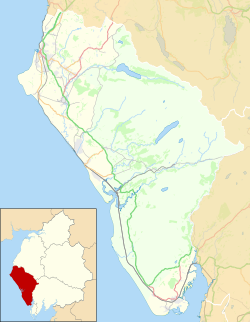| Irton with Santon | |
|---|---|
 The Bridge and inn at Santon Bridge | |
Location within Cumbria | |
| Population | 316 (2011) [1] |
| Unitary authority | |
| Ceremonial county | |
| Region | |
| Country | England |
| Sovereign state | United Kingdom |
| Post town | Holmrook |
| Postcode district | CA19 |
| Police | Cumbria |
| Fire | Cumbria |
| Ambulance | North West |
| UK Parliament | |
Irton with Santon is a civil parish in Cumberland, Cumbria, England, which includes the village of Santon Bridge. It has a parish council. [2] It had a population of 373 in 2001, [3] decreasing to 316 at the 2011 Census. [1]
Contents
The parish is bordered by the parishes of Gosforth to the north west and west, Eskdale to the east, Muncaster to the south east, and Drigg and Carleton to the south west. Irton Pike is a hill of 751 feet (229 m) included in Wainwright's book The Outlying Fells of Lakeland , [4] and the River Irt flows through the parish, bridged at Santon Bridge. The parish lies within the Lake District National Park, and the only major road is a short stretch of the A595 along the western edge, passing through Holmrook (a village divided between this parish and Drigg and Carleton).
There are 17 listed buildings or structures in the parish. The Church of St Paul and the medieval tower incorporated into Irton Hall are at grade II* and the rest at grade II. [5] [6] [7]

